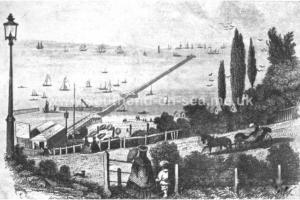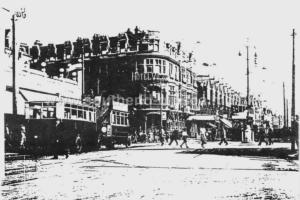A Seaside Town Southend-on-Sea

A Brief History
In
the
early
14th
century
there
appears
to
have
been
a
landing
place
on
the
foreshore.
Grain
was
brought
here
from
Milton,
to
‘Strathende’,
to
be
loaded
on
to
boats
for
transport
to
London.
Strathende
is
thought
to
have
been
at
the
site
of
Southend,
probably
near
the
site
of
the
old
Kursaal.
However,
it
was
not
until
the
end
of
the
15th
century
that
we
find
the
first
mention
of
the
name
‘Southend’.
The
name
appears
in
a
will,
dated
1481
,
as
a
geographical
term,
making
reference
to
a
settlement
on
the
shoreline
at
the
south
end
of
Prittlewell
Parish.
“...venella
vocat
Southende
parochie
Beate
Marie
de
Pritwell.”
(Loosely
translated
as
‘a
lane
called
Southend
in
the
parish
of
St.
Mary’s
Prittlewell.’)
At
this
period
Southend
probably
consisted
of
little
more
than
a
lane
leading
to
a
jetty, with a small collection of fisherman’s huts.
The
Settlement
did
not
grow
until
after
the
beginning
of
the
18th
century,
when
the
cultivated
oyster
industry
began
to
develop
here.
The
foreshore
then
became
valuable
property,
and
legal
battles
were
fought
concerning
the
use
and
ownership
of
it.
In
1767
John
Remnant
built
a
row
of
cottages
“one
with
good
accommodation
and
firing”,
for
the
oyster
fishermen.
These
were
known
as
Pleasant
Row,
(demolished
in
the
1960s).
The
following
year
a
scheme
was
proposed
to
“render
Southend
a
convenient
place
for
bathing”.
Although
the
scheme
never
really
got
under
way,
the
Ship
Inn
was
among
buildings
erected
at
this
time.
From
this
period
the
town
began
to
expand,
and
by
1790
there
were
19
houses
in
the
‘town’;
in
1793
a
theatre
was
opened,
and
two
years
later,
the
Caroline
cold
and warm sea water baths were opened.
At
this
period
Southend
was
that
area
around
the
site
of
the
Kursaal,
the
buildings
concentrated
along
the
foreshore.
The
principal
road was Southend Lane, and the southern end of Southchurch Avenue.
Southend
was
becoming
a
popular
resort,
although
still
trailing
well
behind
Brighton
and
Margate.
However,
in
1791,
under
the
promotion
of
Thomas
Holland,
the
Grand
Terrace,
Grand
Hotel
and
Library
were
built
on
a
prominent
ridge
to
the
west
of
the
‘Old
Town’.
The
scheme
also
included
Assembly
and
Coffee
Rooms.
One
writer
described
this
development
as
an
‘Earthly
Paradise’
and
‘I
doubt
not
but
South
End
will
be
the
rage’.
A
visitor
to
the
old
town
at
this
period
describes
“....the
humble
cottages
of
the
fishermen
interspersed
with
a
few
houses
neatly
built
and
finished
as
lodging
houses..;
whilst
the
Inns
offered
viands
and
wines
not
at
all
inferior to those of the Grand Hotel and....on much more reasonable terms.” The Terrace and Hotel was completed in 1793.
The
Terrace
was
renamed
“Royal”
following
the
visit
to
the
Upper
Town,
of
Princess
Caroline,
in
1804.
Her
daughter,
Princess
Charlotte,
had
visited
the
Lower
or
Old
Town,
for
the
bathing,
three
years
earlier.
She
was
attended,
it
is
said,
by
a
Mrs
Glasscock,
her
personal
‘dipper’.
The
“Globe”,
in
1806
began
to
publish
a
list
of
Society
visitors
to
the
now
fashionable
resort,
and
so
popular
was
the
town
that
the
local
inns
were
not
large
enough to accommodate all the visitors.
From
the
early
19th
century
passenger
ships
carried
visitors
from
London
to
the
resort
of
Margate,
usually
passing
by
Southend
for
lack
of
landing
facilities.
There
were
local
pleasure
craft
and
barges,
owned
by
Mr.
Mayall,
Mr.
Cockerton,
and
Mr.
Vandervord;
however,
apart
from
short
jetties
and
‘hards’,
no
pier
existed
for
passengers
and
goods
landing
at
low
water.
Those
who
did
land,
had
to
be
carried
on
the
backs
of
fishermen
to
the
shore.
In
1828,
a
group
of
local
landowners,
who
could
foresee
the
benefit
of
increased
trade
and
traffic,
met
at
the
Royal
Hotel,
and
proposed,
among
other
things,
that
a
pier
should
be
erected.
Therefore
an
Act
of
Parliament
was
to
be
sought,
prompted
by
by
Sir
William
Heygate,
one
of
the
local
landowners,
former
resident
of
Royal
Terrace,
and
former
Lord
Mayor
of
London.
The
scheme
was
to
be
financed
through
subscriptions
and
shares,
and
the
money
recouped
through
toll
charges
on
goods
and
people.
After
some
arguments,
and
various
objections
the
pier
was
built
at
the
foot
of
Royal
Terrace
ridge,
and
a
toll
house
erected
at
its
entrance.
On
the
east
side
of
the
pier
was
a
harbour,
consisting
on
little
more
than
breakwater;
the
pier
was
opened in 1830, and was built almost entirely of wood.
The
journey
from
ship
to
shore
was
still
not
an
easy
or
particularly
pleasant
affair.
A
vessel
named
“Clarence”
had
been
purchased
by
the
newly
formed
Southend
Pier
Company,
and
anchored
off
the
end
of
the
pier.
Passengers
would
disembark
on
to
this
stationary
vessel,
and
then
be
rowed
by
small
craft,
or
walk,
depending
on
the
the
state
of
the
tide,
to
the
pier.
This
vessel
was
later
replaced
by
the
‘Lighthouse’
or
‘Mount’.
By
1846,
however
the
pier
was
extended
to
1
¼
miles
in
length,
with
a
wide
landing
stage
and
three
birthing
places.
In
the
same
year
the
Southend
Pier
Company
sold
the
pier
by
public
auction,
which
realised
£17,000.
In
c1874
the
structure
was
purchased
by
the
Local
Board,
and
twelve
years
later
the
decision
was
taken
to
replace
the
old
wooden
structure
with
a
new
one
made
from
iron
and
steel.
Sir
James
Brunlees
was
to
be
the
engineer.
This
new
pier,
begun
in
1885
alongside
the
old
one,
was
opened
in
1889,
complete
with
new
brick
entrance.
In
1890
the
pier
rail
track
was
completed
and
the
first
electric
tram
was
operational.
This
replaced
the
horse
drawn
tram
which
had
carried passengers along the length of the wooden pier.
In
1901/1902
a
water
chute
was
built
in
part
of
the
old
harbour,
against
the
east
side
of
the
pier,
to
be
replaced
quite
soon
afterwards
by
a
boating
pool.
In
1908
the
upper
deck
of
the
pier
extension
was
opened
and
by
1930
the
pier
measured
2158
meters
in
length.
In
the
following
year
the
old
pier
entrance
was
demolished,
to
make
way
for
the
widened
pier
entrance
and
new
seaside
road.
The
pier
became
most
popular
towards
the
middle
of the century, with over 2 ½ million people using the pier in 1950.
From
1787
a
regular
stage
coach
service
was
operated
between
the
“Ship”
at
Southend
and
the
“Bull”
in
Aldgate.
By
1806
two
coaches
daily
arrived
at
the
town,
beside
the
frequent
post
chaises.
Southend
was
becoming
fashionable,
but
the
only
roads
into
the
town
were
the
Turnpike
routes,
from
Hadleigh
and
Rayleigh.
The
first
paddle
steamer
on
the
Thames
was
the
‘Marjory’
or
Margery,
closely
followed
by
the
‘Argyle’,
later
renamed
the
the
‘Thames’,
which
begun
operating
in
July
1815.
The
Sir
Joseph
York
was
acquired
in
1824
by
the
General
Steam
Navigation
Company,
and
used
on
the
London-Southend-Sheerness
run.
However,
the
town’s
population
did
not
begin
to
grow
appreciably
until
the
building
of
the
first
railway
line
to
Southend
made
travelling
to
the
resort
easy,
fast
and
reasonably comfortable.
After
much
discussion
by
several
railway
companies,
it
was
decided
to
lay
a
track
along
the
coastline,
to
terminate
at
the
pier.
However,
after
objection
from
the
residents
of
Royal
Terrace,
who
claimed
they
would
be
disturbed
by
the
noise
and
stress,
the
station
was
finally
located
to
the
north
of
the
Upper
Town,
on
the
present
site
of
Southend’s
Central Station.
The
line
was
constructed
by
the
Eastern
Counties
and
Blackwall
Railway
Companies,
and
leased
to
Messers.
Peto,
Brassey
and
Betts.
The
line
was
completed
to
to
Southend
and
opened
in
1856.
In
1889
the
Great
Eastern
Railway
was
extended
to
Southend,
with
terminus
at
the
south
end
of
Victoria
Avenue.
With
cheap
and
easy
travel,
the
resident
and
visitor
population
of
the
town
grew
rapidly
after
the
mid
19th
century,
and
it
soon
became
necessary
to
provide
an
efficient
public
transport
system
within
the
town.
Before
the
end
of
the
19th
century
the
only
form
of
public
transport
was
the
horse
drawn
coach
or
bus,
and
the
smaller
vehicles,
such
as
the
‘fly’
operated
by
Peter
Trigg.
The
Trigg
family
were
proprietors
of
several
of
the
town’s
inns,
from
which
the
fly
and
coach services operated.
In
1898
plans
for
a
tramway
system
were
prepared
by
the
Corporation’s
Light
Railway
Committee.
The
service,
radiating
from
Victoria
Circus,
on
a
3’
6”
gauge
begun
in
1901.
In
1910
a
ticket
office
and
waiting
room
were
built
at
Victoria
Circus,
as
the
number
of
visitors
to
the
town
increased
yearly.
However,
as
motor
bus
services,
operated
by
the
Westcliff
Motor
Services
Ltd.,
grew
in
number,
and
the
tramway
services
were
never
sufficient
during
the
season
to
cope
with
the
number
of
visitors,
the
tram
services
declined. They were replaced, after 1935, with trolleybus, and then by the omnibus.
With
the
growth
of
population
and
visitors
to
the
town,
new
roads
were
built,
and
housing
estates
grew
up.
The
first
of
the
new
housing
estates
was
‘New
Town’
or
the
‘Cliff
Town’
estate,
developed
by
Messrs.
Peto,
Brassey
and
Betts,
and
later
Porter’s
Town.
The
Park
Estate,
Burgess
Estate,
etc.
In
1892
the
town
achieved
Municipal
Borough
status.
The
greens,
which
fronted
Marine
Parade
(Fairhead’s
Green,
Darlow’s
Green,
and
Pawley’s
Green)
were
purchased
by
the
Corporation
and
the
road
widened.
These
greens
had
been
the
traditional
site
for
market
stalls
and
side
shows,
and
many
years
previously,
fairs
had
been
held
on
Fairhead’s
Green.
From
1884
the
greens
were
levelled
and
laid
out
with
grass
and
flowers.
Westcliff
and
Chalkwell
Esplanade
were
laid out in 1903 and, after 1930, the Pier entrance was widened and road continued.
The
High
Street,
in
1870,
was
little
more
than
a
country
lane,
leading
from
the
‘White
Gate’
to
the
shore.
About
halfway
down
this
road
stood
Mr.
Attridge’s
cottage,
a
small
thatched
building
building
adjacent
to
a
shell-fish
stall.
The
principal
commercial
streets
at
this
time
were
Nelson
Street
and
Alexandra
Street;
at
the
corner
of
this
and
the
High
street
stood
John
Rumbelow
Brightwell’s
drapery
shop
(founded
in
1872.)
Opposite
was
Baker
and
Wiseman’s
timber
yard;
near
the
London
Tavern
was
Tyler’s
Field,
and,
by
1873 Thomas Dowsett had opened his stores.
Luker’s
Brewery
was
to
the
north
of
Attridge’s
Cottage;
Mrs
Edward’s
Tobacconist
was
near
by,
and
in
1890
R.
A.
Jones
opened
his
Jewellers in the High Street. In the previous year, William Heddle had opened his Cash Clothing Stores.
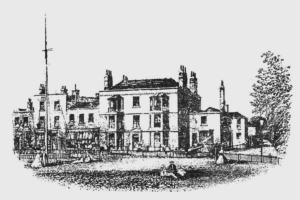

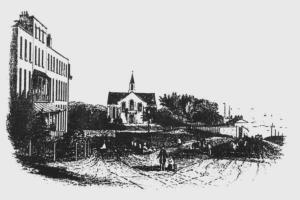
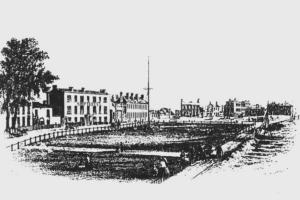
Rayleigh House, Strutts Parade (now Marine
Parade)
The Ship Hotel from the Beach
Royal Hotel
Grove Terrace and Church

1832 Southend Terrace
The Wooden Pier
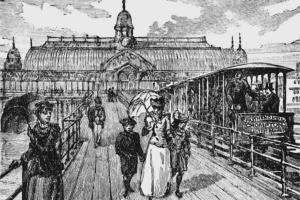
Electric Railway on the Pier
Railway Station and Refreshment Room
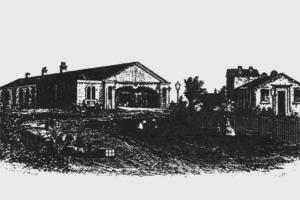
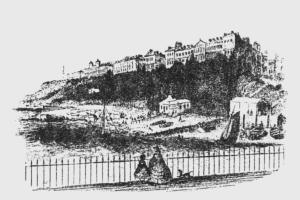
New Town and Shrubbery from the Pier
In the last few years of the 19th century the north end of the High Street was developed, the Victoria Hotel built and rows of shops
were built, with living accommodation above. Several photographic studios were opened, among which was Shepard’s Studios. and
Lawton’s School of Photography and some well known names had come to Southend including Garons and the Penny Bazaar (later
on the site Marks and Spencer). In 1906 the Public Library was built at the south end of Victoria Avenue, and in 1914 the town
achieved County Borough status. By that time Southchurch and Leigh had been incorporated into the Borough, and in 1933 Shoebury
and Eastwood were taken into the expanding Borough boundaries.
1914 the town achieved County Borough status,
the reading of the Charter of Incorporation at
Pier Hill
c1925 Hotel Victoria
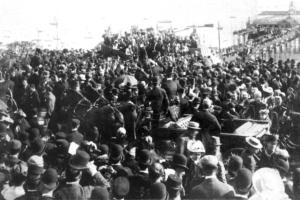
Southend Timeline Southend-on-Sea © 2009 - 2024. All Rights Reserved


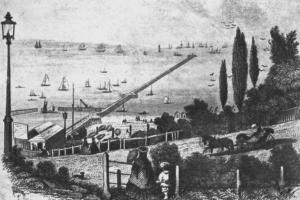
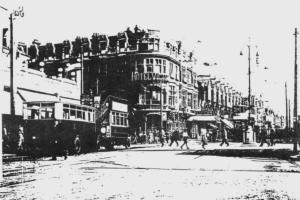


Website Info:

Southend-on-Sea’s No 1 History Website! Documenting The Town & The Townspeople
Now Incorporating The Sea Of Change Website


SOUTHEND CITY
Chalkwell ▪ Eastwood ▪ Leigh-on-Sea ▪ Prittlewell ▪ Shoeburyness ▪ Southchurch ▪ Thorpe Bay ▪ Westcliff-on-Sea
